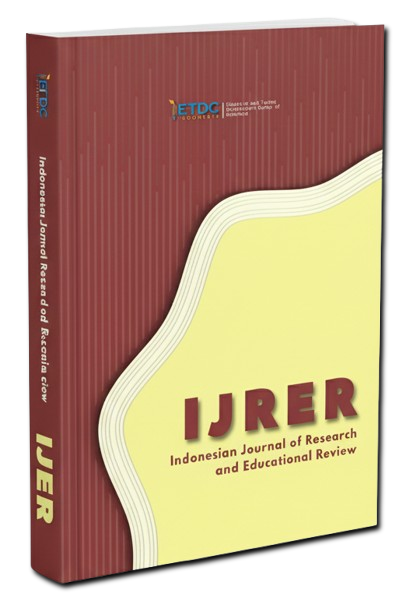Study of Digital Learning Media Needs Analysis for Students of As'adiyah Sengkang Islamic Institute
https://doi.org/10.51574/ijrer.v3i3.2712
Keywords:
Digital Learning; Media; Students; Higher EducationAbstract
In the modern era, which is increasingly oriented toward technology, the demand for digital learning media in the field of education has significantly increased. This transformation pushes the education sector to adapt to various digital media innovations that are more flexible and interactive. Commonly used media include presentations, e-books, and learning applications. Digital learning media is not only needed to replace conventional methods but also offers various advantages, particularly in terms of flexibility, accessibility, and deeper engagement for students. One of the most needed types of digital learning media is media that allows for interactive presentations and digital books that support the delivery of material. Both play a crucial role in enriching the teaching and learning process from the perspectives of both educators and students. This study employs a qualitative descriptive research method using educational, sociological, and communication approaches. Data collection techniques, as well as the research instruments, include interviews with lecturers and questionnaires distributed to students at the Islamic University of As'adiyah Sengkang (UNISAD). During data collection, the researcher conducted a descriptive analysis of the interviews and questionnaires and combined the results using data triangulation. The findings of this research on digital learning media present an interesting and effective alternative for lecturers to deliver material in a more dynamic and visual way, which attracts students' interest and enhances their understanding of the material being taught. Furthermore, through this media, students can become more active in the learning process, as they have the opportunity to explore and comprehend the material independently. The media frequently used by lecturers include presentation tools, e-books, learning applications or games, and educational videos. The media used are tailored to the needs of both students and lecturers. Digital learning media is an absolute necessity in the digital era, but at the Islamic University of As'adiyah Sengkang (UNISAD), there are limitations, such as the lack of computers in classrooms and projectors, which pose challenges for some students in accessing digital learning media. Additionally, technical difficulties, such as unstable internet connectivity or a lack of infrastructure support, can also affect the effectiveness of this media. Therefore, efforts are needed to overcome these obstacles so that the benefits of digital learning media can be experienced equally by all students, allowing the media to be used optimally.
References
Arifin, Zainal. Pengajaran Microteaching: Konsep dan Aplikasinya. (Bandung: Remaja Rosdakarya, 2019)
Afifuddin, M.M, Metode Penelitian Kualitatif, (Bandung: CV Pustaka Setia, 2018)
Diana Widhi Rachmawati,dkk, Metodologi Penelitian (Makassar: Cendekia Publisher, 2022)
Fandi Rosi Sarwo Edi, Teori Wawancara Psikodignostik,(Yogyakarta:LeutikaPrio,2016)
https://elibrary.unikom.ac.id/1279/9/UNIKOM_Benedicta%20A_Bab%203.pdf. Diakses tanggal 11 Agustus 2024 pukul 14.00
https://repository.radenfatah.ac.id/17838/4/4_BAB%20III.pdf Diakses tanggal 11 Agustus 2024 pukul 14.15
https://publishjurnal.com/2023/08/31/sumber-data-primer-sekunder-tersier/ Diakses tanggal 30 September 2024 pukul 11.13
https://penerbitdeepublish.com/sumber-data-penelitian/ Diakses tanggal 30 September 2024 pukul 11.44
https://daftarkampus.spmb.teknokrat.ac.id/apa-itu-sumber-sekunder Diakses tanggal 30 September pukul 11.51
https://repository.iainpare.ac.id/id/eprint/3138/4/16.3300.047%20BAB%203.pdf diakses tanggal 8 Oktober Pukul 17.00
https://pjj.pens.ac.id/index.php/dasar-hukum/ diakses tanggal 10 Oktober 2024 pukul 15.00
https://uin-malang.ac.id/r/101001/triangulasi-dalam-penelitian-kualitatif.html Diakses tanggal 7 Oktober 2024 pukul 13.40
H. Rifa’I Abubakar, Pengantar Metodologi Penelitian, (Yogyakarta: SUKA-Press UIN Sunan Kalijaga,2021)
Maryam B. Gainau, Pengantar Metode Penelitian, (Yogyakarta: PT. Kanisius, 2016)
Moleong, Lexy J. Metodologi Penelitian Kualitatif. (Bandung: PT Remaja Rosdakarya,2018
Peraturan Menteri Pendidikan dan Kebudayaan Republik Indonesia Nomor 14 Tahun 2014 tentang Kebijakan dan Standar Nasional Pendidikan Tinggi.
Permendikbud No. 3 Tahun 2020 tentang Standar Nasional Pendidikan Tinggi, pasal 12, ayat 2.
Putra, A. Pengembangan Media Pembelajaran Berbasis Web untuk Meningkatkan Interaksi Belajar. (Yogyakarta: Pustaka Ilmu, 2023)
Prabowo, H. dan Setiawan, Y. (2021). Tantangan dan Solusi dalam Penggunaan Media Pembelajaran Digital di Sekolah. Surabaya: Penerbit Inovasi.
Rahmadani, B. (2021). Aplikasi Pembelajaran Interaktif. Bandung: Pustaka Educare.
Rudianto, I. (2020). Pengaruh Media Digital terhadap Motivasi Belajar Siswa. Jakarta: Penerbit Edukasi.
Sugiyono, Metode Penelitian Kuantitatif, Kualitatif
Santoso, B. (2022). Penerapan Teknologi dalam Pembelajaran: Video sebagai Media Pembelajaran Efektif. Jakarta: Media Edukasi.
UUD RI Nomor 12 Tahunn 2012 tentang Pendidikan Tinggi Pasal 1 Ayat 2, Nomor 63
Wahdad Najib Habiby, Statitistik Pendidikan, (Surakarta: Muhammadiyah University Press, 2017)
Downloads
Published
How to Cite
Issue
Section
License
Copyright (c) 2025 ETDC: Indonesian Journal of Research and Educational Review

This work is licensed under a Creative Commons Attribution-ShareAlike 4.0 International License.


























